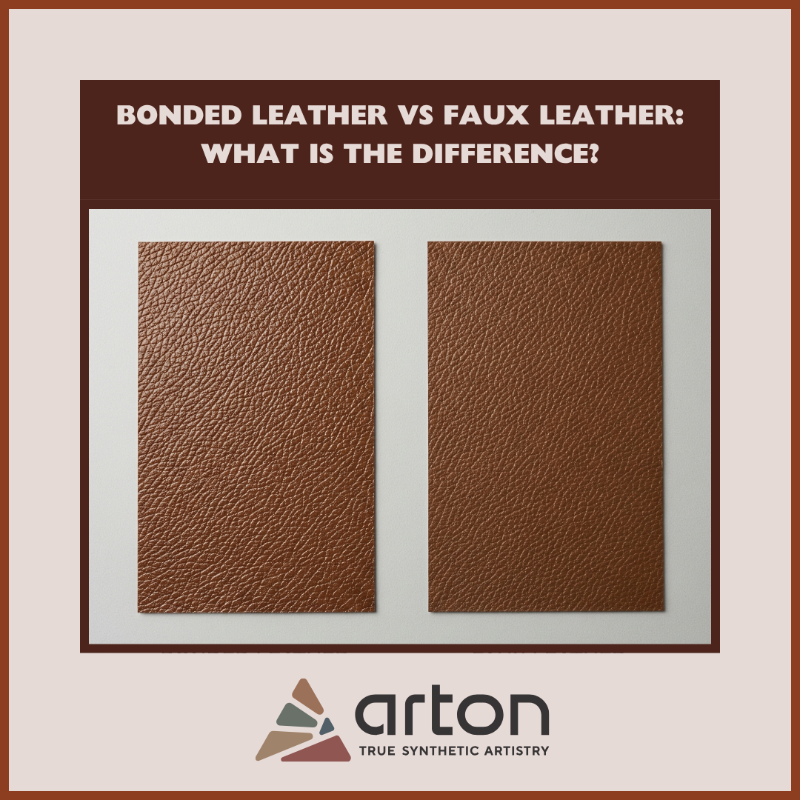01 August, 2025
When you are buying leather alternatives, you are more likely to see two of the most common types namely bonded leather and faux leather. Although they might appear the same on sight they are quite different in composition, durability, and price, and environmental sustainability. Being aware of such differences can assist you in making a well-informed decision in purchasing furniture, fashion needs, or even vehicles.
What is Bonded Leather?
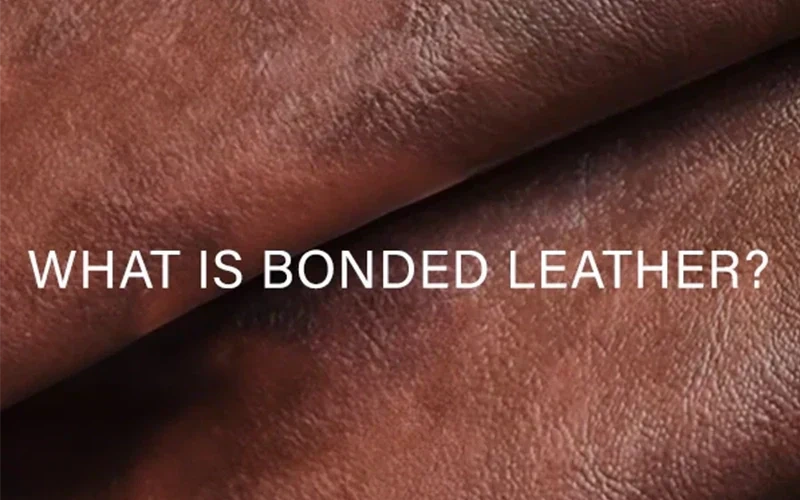
Define bonded leather: A synthetic, made up of leftover pieces of leather mixed with synthetics, intended to be a cheaper imitation of real leather.
Bonded leather otherwise known as reconstituted leather is not pure leather. Bonded leather material in contrast is composed by melding scraps of actual leather, chopped up, and combined with a polyurethane or latex adhesive. This adhesive is then pressed down on a paper or fiber support and embossed so as to resemble the look and feel of actual leather. This is due to the fact that bonded leather actually contains some genuine leather fibers and in marketing terms bonded leather is usually referred to as real leather but one should always know that it contains between 10% to 20% real leather with the remainder consisting of bonding agents and synthetic materials.
Key Features:
- Contains 10–20% genuine leather
- Often embossed to resemble full-grain leather
- Less expensive than real leather
- Prone to peeling or flaking over time
What is Faux Leather?
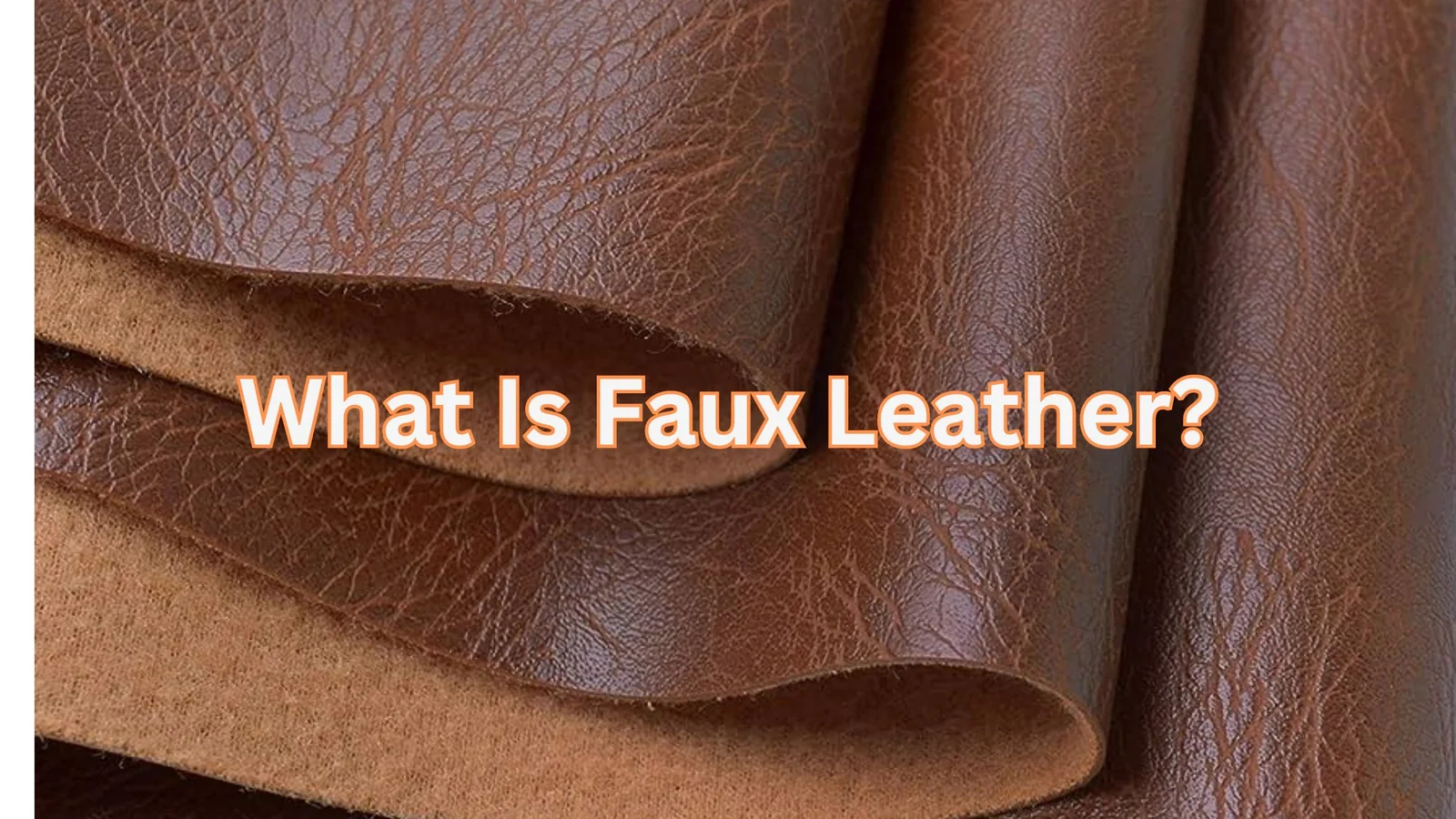
The synthetic leather, or faux leather, or artificial leather or leatherette fabric, is a completely man-made material. Faux leather commonly fabric is an upper (otherwise known as a skin) made of a cloth material (usually polyester) covered with polyurethane or polyvinyl chloride and is textured to look like natural leather grain using embossing. Unlike bonded leather, faux leather has no animal hide in it and therefore is vegan-friendly and often stronger compared to bonded leather.
Other names and variations: leatherette material, artificial leather material, fake leather, PU leather, vegan leather, glitter faux leather, embossed leather.
Key Features:
-
100% synthetic—no animal products
-
More resistant to peeling than bonded leather
-
Available in a wider range of colors and finishes
-
Easier to clean and maintain
How Are Bonded Leather and Faux Leather Made?
Bonded Leather Production
-
Made from shredded scraps and dust from real leather.
-
Mixed with adhesives, then extruded onto a fiber or paper base.
-
The surface is coated (usually with polyurethane) and embossed with a leather-like pattern.
-
Color and gloss are added as a top layer.
Faux Leather Production
-
Synthetic base (usually polyester or cotton canvas) is coated with PU or PVC.
-
Texture is added via embossing to imitate leather grain.
-
Color can vary widely like:
- Black faux leather
- White faux leather
- Red faux leather
- Pink faux leather
- Green faux leather
- Purple faux leather
- Yellow faux leather
- Gold faux leather
- Grey faux leather
Difference Between Bonded Leather & Faux Leather
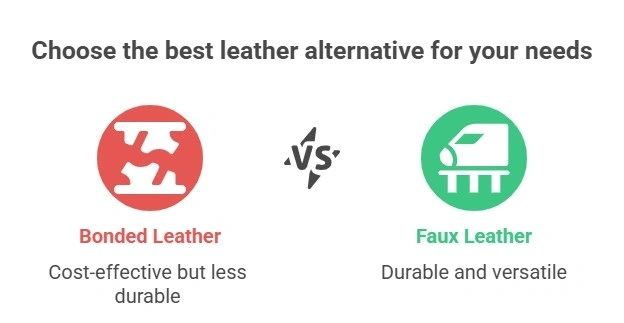
Bonded leather and faux leather are different and it is very important to understand these two terms when planning on buying furniture, accessories, or car upholstery. Both present as alternatives to real leather, but in terms of composition, performance and attractiveness, they vary in a number of ways.
1. Composition
Bonded Leather: Composed of shredded scraps of genuine leather that is blended with synthetic ingredients all held together with a backing. It is made with 10–20% genuine leather, most of which is polyurethane, or latex.
Faux Leather: Faux leather, also referred to as synthetic leather or leatherette fabric, is free of animal products. It is completely man-made - generally a fabric backing (such as polyester) which is covered with polyurethane (PU) or polyvinyl chloride (PVC).
2. Appearance and Texture
Bonded Leather: They are often made to feel and look as naturally as possible with the same grain as that of real leather. It can appear and feel like actual leather, but the bonded leather finish is prone to wear out.
Faux Leather: Available in a vast variety of colors and textures, including traditional black faux leather and brown faux leather as well as glitter faux leather or embossed faux leather. It is smooth in structure and shine.
3. Durability
Bonded Leather: Easily cracked, peeled and flaked, particularly during areas experiencing heavy traffic such as bonded leather upholstery. It normally does not last long, commonly 2 to 5 years, with tender treatment.
Faux Leather: Generally more long-lasting, and able to avoid fading, staining, and scratching. The faux leather used in upholstery of good quality can last several years.
4. Cost
Bonded leather: This is normally the least expensive as it uses leftover materials of leather and synthetics. Present most often in low-cost furniture and bolt-on decorations.
Faux Leather: Moderate priced—More affordable than real leather, but slightly more expensive than bonded leather because it is more durable and wide in variety.
5. Environmental and Ethical Factors
Bonded Leather: Way of reusing leather waste and this is a slight environmental advantage. But it is made with chemical adhesives and synthetic overlays and is not biodegradable.
Faux Leather: Is both Vegan and cruelty-free, and it can be used by people who avoid animal products. Nonetheless, the material that is traditionally used to create fake leather material using PVC or PU may have a greater carbon footprint and lead to microplastic pollution unless the material is innovative or made of recycling.
6. Repair and Maintenance
Bonded Leather: It is almost impossible to fix it once it begins to peel or crack. Repair of bonded leather is not usually possible, so it is usually replaced.
Faux Leather: Simple to wipe and clean especially using a wet sponge and soft detergent. Surface scratches which are minor in nature may not be apparent so easily and they can occasionally be repaired.
Key Differences Between Bonded Leather and Faux Leather
| Feature | Bonded Leather | Faux Leather |
| Source | Real leather scraps & synthetics | 100% synthetic |
| Animal Content | 10–20% leather fibres | None |
| Other Names | Reconstituted leather, blended leather | Leatherette, vegan leather |
| Durability | Prone to cracking and peeling | More consistent, less likely to peel |
| Appearance | Mimics leather, can vary in quality | Uniform, variety of finishes |
| Cost | Usually cheapest option | Mid-range (cheaper than genuine, pricier than bonded) |
| Eco-friendliness | Uses leather waste | No animal products, some forms recyclable |
Pros and Cons: Bonded Leather vs Faux Leather
Bonded Leather
Pros:
- More affordable than real or faux leather.
- Uses leftover leather—reduces waste.
- Can look and feel similar to genuine leather (at least initially).
Cons:
- Prone to cracking, peeling, and fading.
- Surface finish will wear or flake off, especially in high-use areas.
- Fixing bonded leather can be a major challenge.
- Shorter lifespan, especially for bonded leather upholstery.
Faux Leather
Pros:
- Huge range of designs and colors (black faux leather, brown faux leather, even printed faux leather).
- Usually more durable than bonded leather; resists cracking and stains.
- Easy to clean; nonporous surface.
- 100% animal-free; suitable for vegan and cruelty-free lifestyles.
Cons:
- Does not develop the same patina or softness as real leather.
- Some lower-quality products can have a plastic feel.
- Less breathable than genuine leather.
Applications of Bonded Leather & Faux Leather
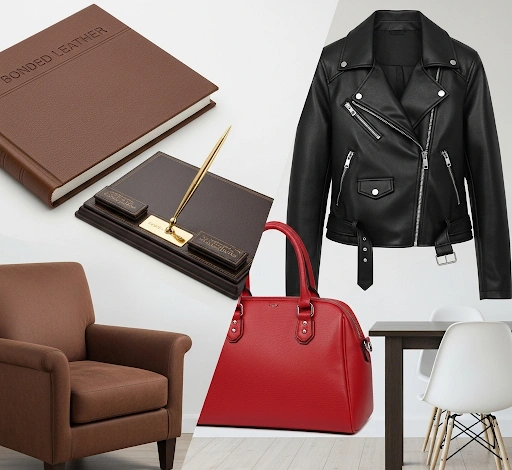
Bonded Leather Applications
-
Furniture and Upholstery: Universal favorite in the budget sofas, chairs, and head boards including brown bonded leather products.
-
Accessories: The material is used in wallets, belts, coverings on books and cases, and handbags- some of which are labelled as cabra bonded leather, giving it a distinctive feel.
-
Automotive Interiors: Applied in seat covers and the trim of mid-range cars in order to give a bonded leather appearance.
-
Bookbinding: Ideal with diaries, planners, and religious manuscripts because of its neat look.
Faux Leather Applications
-
Dressing and Accessories: Jackets, pants, shoes, and more, made of faux leather material are a trending color that includes purple Faux Leather, yellow Faux Leather, and white Faux Leather.
-
Upholstery and Furniture: Used in restaurant booths, couches, and chairs where faux leather for upholstery excels.
-
Automotive and Marine: Artificial leather offers advantages of being waterproof, making it really useful in boat seating and dashboards.
-
Accessories: They are in fashionable faux leather bags, belts, wallets and suppliers of fake leather who have a range of products all over the world.
-
Decorative and Specialty Products: Wall panels, pillows and embossed faux leather notebook covers are both functional and stylish.
Why Choose Faux Leather Over Bonded Leather?
Faux leather offers a consistent finish, wide range of color options (like grey faux leather, gold faux leather), and better durability. It's cruelty-free and fits modern sustainability goals better than bonded leather.
Which is Better for Upholstery and Furniture?
Faux leather for upholstery is the superior choice in most cases due to its longer life, stain resistance, and easy care. Bonded leather upholstery, while cost-effective, deteriorates faster.
How to Care for Each Material
Caring for Bonded Leather
- Wipe spills immediately.
- Avoid harsh cleaners—use mild soap and a damp cloth.
- Protect from sunlight to reduce fading.
- Regular cleaning can help, but fixing bonded leather isn't always possible.
Caring for Faux Leather
- Clean with a soft cloth and mild soap.
- Avoid abrasives.
- Available cleaning products for artificial leather material make care simple.
Conclusion
Comparing bonded leather vs faux leather, one can see that faux leather is more durable, versatile, and sustainable, especially as a use in upholstery, as vehicle interior material, and in clothing. Both bonded and faux leather are cheaper substitutes to genuine leather. Bonded leather material is a cost-effective way of reusing waste and looking good like leather, but it is not long lasting. Leatherette, also known as faux leather, is an alternative to leather because it is durable, eco-friendly, and highly versatile and can be used in contemporary settings and lifestyles.
Rock Uniquoters engage with the high-quality manufacturing and supply of synthetic faux leather solutions with high-impression performance ratings, good looks, and practical functionality. We guarantee the production of eco-friendly, reliable, and aesthetically impressive materials that match diverse industries due to our state-of-the-art production. Rock Uniquoters offer ultimate quality and innovation whether you need sustainable alternatives or designed finishes.
Common Questions: People Also Ask
1. What is the difference between bonded leather and faux leather?
Bonded leather contains real leather remnants with synthetic binders, while faux leather is completely man-made. Faux leather is more durable and easier to maintain.
2.How Long Does Bonded Leather Last?
The bonded leather quality is usually lower. Items like bonded leather upholstery last 2 to 5 years before cracking or peeling.
3. Is Faux Leather Durable?
Yes. Faux leather for upholstery resists wear and tear well, making it ideal for regular use.
4. Is faux leather vegan and cruelty-free?
Absolutely. Faux leather contains no animal products and is widely adopted in vegan leather markets.
5. How do I clean and maintain faux leather?
Use a damp cloth with mild soap. Avoid harsh chemicals. Special faux leather material cleaners can help keep it in top shape.

